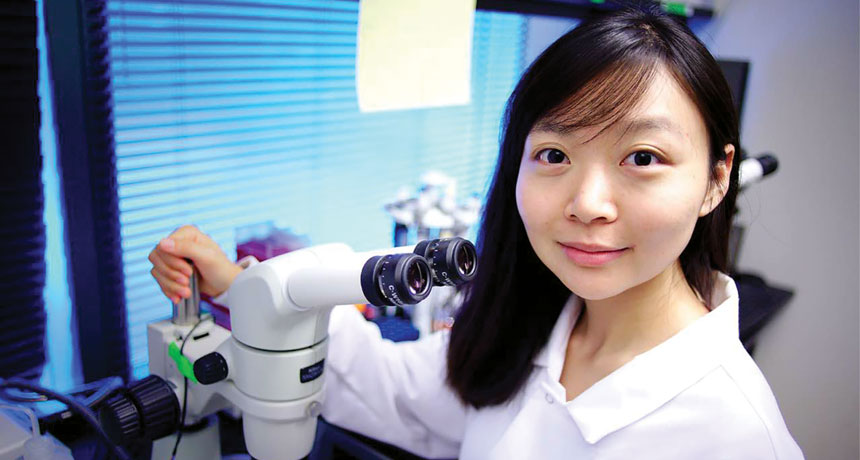Luhan Yang strives to make pig organs safe for human transplants

Biologist Luhan Yang dreams of pig organs that will one day fly — into people. If she has her way, animal farms will raise herds of bioengineered pigs, designed to produce kidneys, livers and other organs that could be transplanted into humans. Animal parts would slip seamlessly into people, easing their suffering.
“There are millions of patients worldwide waiting for organ transplants,” says Yang, who is chief scientific officer of eGenesis, a biotech start-up in Cambridge, Mass. “It’s such a huge unmet need.”
Researchers have long dreamed of using animal organs to alleviate the shortage of human ones, a field called xenotransplantation. So far those efforts have ended in failure, usually with the person’s immune system rejecting the transplanted animal organ.
But Yang has both the tools and the drive to change that. She is pioneering the direct editing of mammals’ genetic instruction books, or genomes, working to tweak DNA to make pig organs more acceptable inside humans. All before her 32nd birthday.
“Luhan is exceptionally bold, yet careful,” says George Church, a biologist at Harvard University who oversaw Yang’s Ph.D. work and then cofounded eGenesis with her. “She is unstoppable.”
Yang grew up in Sichuan province in southwestern China, at the base of a mountain that inspired a fascination with nature. In high school she developed biology skills thanks in part to a teacher who took classes into the woods to learn about plants and animals. She passed a rigorous set of exams and was chosen for China’s team for the International Biology Olympiad, where she won a gold medal in 2004.
At Peking University in Beijing, she studied not only life science but also added a second major, psychology. “The human brain and thinking are the most mysterious part to me,” she says. That background later served her well in navigating the fast-paced management of biotech start-ups.
In 2008, Yang moved to the United States to explore options for her Ph.D. work. Intrigued by the medical applications of basic research, she rotated through laboratories in cardiology and cardiovascular disease before settling on Church’s group. She says its innovative approach to genome engineering was a better match for her desire to look at biological problems holistically. This was, after all, the lab that tasked itself to engineer an embryo of a woolly mammoth.
Language difficulties nearly derailed Yang at first. But she persevered to improve her English while beginning to rack up achievements. New methods of genome engineering were popping up regularly, and she knew she could either work on techniques that already existed and churn out publications — or dive in and work on risky projects with a potentially greater payoff. “We didn’t try to ride a trend,” she says. “We tried to pioneer a field.”
The gamble worked, thanks to the game-changing CRISPR/Cas9 gene editing technique that was just beginning to take off. With CRISPR, biologists could precisely and permanently modify genes in living organisms; Yang dove right in to push the technology in new directions. In 2013, in the journal Science, a team led by her and bioengineer Prashant Mali, now at the University of California, San Diego, stunned the scientific world by reporting CRISPR gene editing in human stem cells. And in 2015, Yang reported figuring out a way around one of the biggest problems in pig-organ transplants.
Pig cells contain retroviruses that may infect human cells when transplanted. In a 2015 paper in Science, Yang, Church and others described a method, using CRISPR in cell lines, to(SN: 11/14/15, p. 6). It was the most genetic modifications anyone had ever made to a mammalian genome and opened the door to new ways of circumventing rejection problems with pig organs.
With her Ph.D. in hand, Yang cofounded eGenesis. Her next goal is to create what she calls “Pig 2.0,” which will be not only free of the harmful retroviruses but also incorporate additional genetic tweaks to get around immune rejection. In August, the team reported another step toward that goal: The researchers had raised not just cell lines that were free of the retroviruses, but 15 live piglets in which problematic retroviruses had been eliminated (SN: 9/2/17, p. 15). “This will be an important foundation for building a better pig for transplantation,” says Philip O’Connell, a transplant specialist at the University of Sydney in Westmead, Australia. “They have made the prospect of xenotransplantation a lot safer.”
The next step is to see how long the pigs live and what long-term effect the gene editing has on them. “2017 is a very important year for eGenesis,” Yang says.
After years in academia, Yang likes being in the stimulating biotech culture of Kendall Square, where at a restaurant lunch she can hear people brainstorming innovative ways to tackle disease. She continues to work on ambitious side projects such as, with Church and others, an effort to synthesize human genomes from scratch. In her limited spare time she plays badminton, runs and hikes — but most of all she reads.
Each year she chooses a theme for her books: One year it was Western art history, and another it was detective novels. For 2017 she is focusing on books about leadership, to better handle the management decisions that come with heading a driven, 14-person team. (She recommends True North, from Bill George, a former Medtronic CEO, for tips on how to be an inspiring leader.)
For Yang, there is no slowing down at the top. “We strive to create a world where there is no organ shortage,” she says. “We understand it is a very audacious vision. We get up every day to work on that.”